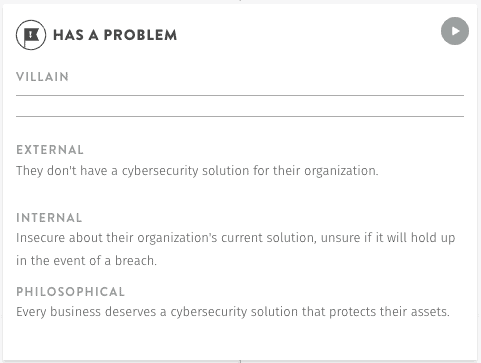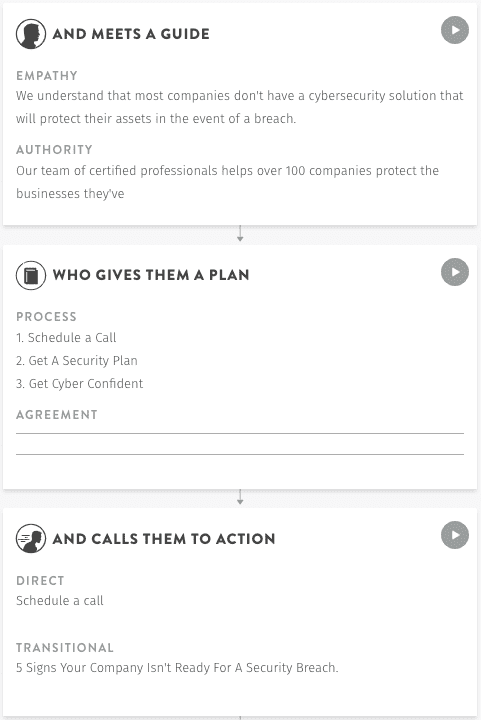If you’ve read our recent blog, What is the Storybrand Brandscript?, you know that a Brandscript helps companies organize the story they’re telling so their customers listen. Most companies don’t talk about what they do in a way that generates interest from their target audience—resulting in money wasted on sales and marketing. StoryBrand created the Brandscript to help companies avoid bad messaging that confuses their audience and instead tell a story that centers around the customer, helping them understand and buy. In this article, we’re going to walk you through a Storybrand Brandscript example so when you complete a Brandscript at your company, you can be confident that you’re doing it correctly.

Why Most Brandscript-Imitators Don’t Work
Whether companies realize it or not, their messaging is following some sort of script. For most companies, their “script” goes something like this:
1. What do we do?
2. How do we prove we’re the best at it?
By the time these guiding questions are answered and turned into website copy, the website looks more like a company trying to prove its worth and less like a website that is truly helpful for its audience. A potential customer then visits the website, sees a company that talks primarily about itself, and, as a result, doesn’t see a company that’s the right person for the job.
If done correctly, the StoryBrand Brandscript doesn’t make a company’s story about the company, but about their customer. If your website is primarily about what your audience wants, the problem that’s in their way, and how they can solve it—your audience will go from confused about your offering to crystal clear about how you can help them.
Here’s a StoryBrand Brandscript example from a cybersecurity company we’ve worked with.
How to Turn The StoryBrand Brandscript Into A Homepage Header
If you want your audience to understand your offering you should start by identifying what they want. In the Brandscript above, we identified an audience that is searching for a cybersecurity company. They want their organization and assets to be protected.
Now, when it comes time to create a header for your homepage you take what your customer wants and what the result will be if they get what they want. This initial shot of clarity allows your audience to see where you can take them, allowing them to begin with the end in mind.
The header this company went with for their website was, “Comprehensive Cybersecurity to Protect Your Business.” A lot of companies are trying to come up with something clever for their H1 to wow their audience. Instead, what if you just asked, “What does your customer want?”. That’s what you need to show them.
When your marketing collateral identifies what your audience wants and what success will look like when they achieve it (check out the “Ends in Success” section of the Brandscript), you are well on your way to creating a message that your customer understands and buys.
How The StoryBrand Brandscript Overcomes Your Audience’s Objections
While many companies do a good job of identifying what their customer wants, this is only part of the equation. Next, you want to identify what’s keeping your customer from getting what they want. This is accomplished in the “Has a Problem” section of the Brandscript.
The external problem is the problem your customer is actually facing (they don’t have a cybersecurity solution that protects their business). The internal problem is the way the external problem is making them feel (insecure about how safe their organization is). The philosophical problem is why it’s just plain wrong that any one should have to suffer this problem (every business deserves a cybersecurity solution that protects their assets).
It’s important to remember that while your audience looks for you based on an external problem, they buy based on an internal problem. The Brandscript helps you determine the internal problem your audience faces is so your marketing collateral touches on those pain points. Once you have helped your audience realize what they want and what the obstacle is to getting there, you are ready to call your audience to action.

How to Call Your Audience to Action
Unless a character is called to action in a story, they never end up getting what they want. You can identify every point in your audience’s story, if you don’t call them to action, they’re not going to go on the journey of doing business with you.
This section of the Brandscript helps you work through how to call your audience to action in a way that works—using empathy and authority. Because you’ve proven you understand their problem and because you’ve solved it a hundred times for clients just like them, they will listen to the action you suggest. However, it’s also important to remember that not every customer is ready to do business with you just yet. A transitional call to action offers a piece of premium content in exchange for your audience’s email. An email campaign attached to this piece of content helps your audience overcome whatever keeps them from buying. Without a transitional call to action, you will likely end up missing out on business from customers who weren’t quite ready to buy.

Putting It All Together
Without your product or service, your audience is a character that wants something but has a problem. Not dealing with this problem will only lead to bigger problems (and eventually failure).
The Brandscript is designed to show how you can help your audience transform. That’s why it ends with the character’s transformation.

The story you’re telling your audience isn’t as customer-centered as it could be. The story your audience wants to buy is one that portrays transformation and then delivers on it. The Brandscript should influence every word your company uses and create a kind of world that your customer wants to be a part of.
Are you ready to create a Brandscript for your business? Fill one out for free at mystorybrand.com today.
